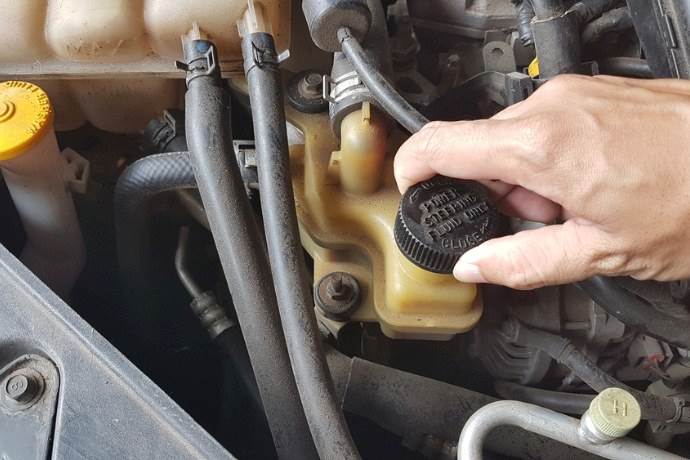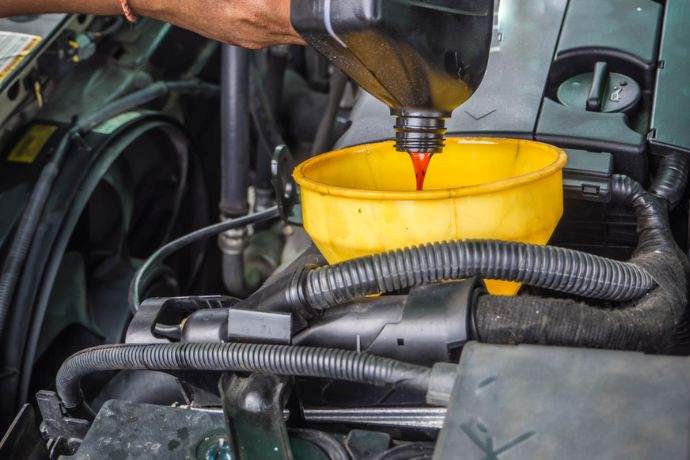Power steering and transmission fluids are different types of fluids with different purposes and properties.
The power steering fluid is used to lubricate the steering system, while the transmission fluid is used to lubricate the transmission’s moving parts.
Many people wonder if power steering fluid can be used as a substitute for transmission fluid. The short answer is no.
Using power steering fluid in the transmission system causes several transmission problems.
So, if the question still persists, “Can you use power steering fluid for transmission fluid?” The answer is no; you should never use power steering fluid for transmission fluid.
Although the power steering and transmission fluids are both hydraulic fluids, their properties are different and not interchangeable. Using power steering fluid in the transmission fluid can cause severe damage to the transmission and lead to premature failure. If you use the wrong fluid in the transmission, you will experience bad transmission symptoms.
There are 6 reasons why you should never use power steering fluid as a transmission fluid:
1. Different Formulations
The power steering fluid does not have the necessary additives to protect the transmission components. Transmission fluid contains detergents, friction modifiers, and viscosity stabilizers.
These additives are designed to reduce friction, wear and tear, and heat buildup.
On the other hand, the power steering fluid does not contain these additives, so it cannot provide the same level of protection for the transmission components.
2. Viscosity Difference
The ATF is thinner than the power steering fluid. Therefore, the power steering fluid cannot perform as appropriately as the ATF does.
However, using the wrong viscosity fluid can hinder the system’s performance and may lead to damage.
3. Durability
The power steering fluid is not as durable as the transmission fluid. Transmission fluid needs to be able to handle extreme temperatures and pressures.
Power steering fluid is unable to handle such conditions and may break down.
4. Functions
The power steering fluid is primarily designed to lubricate and protect the components of the power steering system, including the power steering pump, rack, and hoses.
It also helps transmit hydraulic pressure to the power steering rack, amplifying the driver’s input and making it easier to turn the wheel. In contrast, the transmission fluid has a much more demanding job.
The transmission fluid lubricates and protects all the transmission’s moving parts, including the gears, bands, and clutches.
5. Seal and Gasket Compatibility
Transmission fluid additives keep the seals soft and pliable, which prevents leaks. The power steering fluid does not have the same effect, and using it in the transmission may deteriorate seals and cause leaks.
6. Cost Implications
The wrong fluid may save you a few bucks in the short run but can result in expensive future transmission repairs. These are the reasons why you should never use a power steering fluid for transmission fluid.
However, if you have accidentally used power steering fluid in your transmission, you will notice the following symptoms:
- Slipping transmission
- Hard Shifting
- Overheating transmission
- Burn transmission fluid
- Transmission failure
If you notice any of these symptoms, take your vehicle to a repair shop and flush the transmission ASAP.
What is Power Steering Fluid?

It is an essential hydraulic fluid used in steering systems. The power steering fluid in a power steering system creates a hydraulic link between the steering wheel and the front wheel.
It is responsible for making the steering system easier to turn, especially at low speeds. The fluid also lubricates the moving parts of the steering system and protects them from corrosion.
Power steering fluid typically comprises a base oil, additives, and dyes. The base oil is usually a petroleum-based oil, but synthetic oils can also be used.
Additives help improve fluid performance by reducing friction and wear. The dyes are used to color the fluid so that it is easy to see if there is a leak.
What is Transmission Fluid?

The transmission fluid is a vital substance that is utilized in a vehicle’s transmission system. This complex system allows the engine to transfer power to the wheels and will enable the vehicle to move.
The transmission fluid serves several functions to ensure that the transmission operates smoothly and correctly. It typically comes in green or red. This color differentiates the transmission fluid from motor oil.
The transmission fluid is a mixture of base oils and additives that is designed to perform several functions, such as lubricating the moving parts, keeping the transmission cool, and reducing corrosion and rust.
If the fluid level is low or dirty, the transmission overheats wears out prematurely, or even fails.
Power Steering Fluid Vs Transmission Fluid [Similarities and Differences]

To properly maintain a vehicle, it is necessary to understand the distinctions and commonalities between the fluids used in the vehicle. The power steering fluid and ATF are two of them. While both fluids are important hydraulic fluids in a vehicle, their functions, compositions, and purposes differ.
Let’s see the similarities and differences between power steering and transmission fluid:
Similarities Between Power Steering Fluid and Transmission Fluid
1. Hydraulic Nature: Transmission fluid and power steering fluid are both hydraulic fluids that use hydraulic pressure to transmit power.
2. Lubrication: Both fluids are designed for lubricating moving parts and reducing friction.
3. Protective Function: Both fluids contain additives that help to protect against corrosion and wear.
4. Cooling Properties: Both fluids help their systems cool down by releasing the heat generated during operation.
5. Deterioration Over Time: Both fluids are degraded after certain times and require periodic checks and potential replacement.
Differences Between Power Steering Fluid and Transmission Fluid
1. Function
Power Steering Fluid: The fluid assists the vehicle’s steering system to turn smoothly.
Transmission Fluid: helps the vehicle’s transmission system operate smoothly.
2. Composition
Power Steering Fluid: The power steering fluid is typically a mineral oil with anti-wear, anti-foaming, and anti-corrosion additives.
Transmission Fluid: The transmission fluid is also a mineral oil, but it contains extra additives, like friction modifiers and detergents.
3. Viscosity Difference
There is a difference in viscosity between the power steering fluid and the transmission fluid.
Power steering fluids are slightly thicker than transmission fluid and flow more slowly.
The power steering fluid needs to provide more flow resistance to operate the system properly.
Most power steering fluids have a 40–60 SUS viscosity at 100 degrees Fahrenheit.
4. Color
Power Steering Fluid: Generally red, clear, amber, or pinkish in color.
Transmission Fluid: Generally red or green, but this can change to a brownish hue over time.
The following table distinguishes between power steering fluid and automatic transmission fluid:
|
Feature |
Power Steering Fluid |
Automatic Transmission Fluid |
| Function | Aid in steering |
Aid in automatic transmission and gear shifts |
|
System Served |
Power steering system |
Automatic transmission system |
|
Cooling |
Yes | Yes |
| Lubrication | Yes |
Yes |
|
Typical Color |
Red, clear, pinkish, amber | Red or green |
| Protection | Prevents wear, oxidation, and corrosion |
Prevents wear, oxidation, and corrosion |
What Happens If I Accidentally Put Power Steering Fluid in My Transmission?

If you accidentally use power steering fluid in the transmission, various transmission problems will occur, such as:
- The transmission may overheat.
- The transmission may slip.
- The transmission may wear out prematurely.
- The transmission may fail.
What to Do If You Accidentally Put Power Steering Fluid in Your Transmission?
If you accidentally put power steering fluid in your transmission, flush the transmission as soon as possible. This will remove and replace the power steering fluid with the correct transmission fluid type.
The best way to flush the transmission is to take your vehicle to a repair shop. There, the auto mechanic will use a special machine to flush the transmission fluid and replace it with a new one.
It costs approximately $200 to $250.
How to Avoid Using Power Steering Fluid for Transmission Fluid?
To avoid using power steering fluid for transmission fluid, follow these instructions:
- Be careful when adding fluids to your vehicle.
- Always check the owner’s manual to ensure you use the correct fluid type for each part.
- Label your vehicle’s fluid reservoirs so you can easily identify them.
- If you are confused about which type of fluid to use in a specific part, consult the owner’s manual or a professional mechanic.
How to Check Transmission Fluid

Follow these steps to check transmission fluid:
- Park the vehicle and turn on the engine.
- Let the engine idle for a few minutes.
- Locate the transmission fluid dipstick [consult your owner’s manual for the specific location].
- Remove the dipstick and use a rag to clean it.
- Place the dipstick back in and firmly press it in.
- Now, remove the dipstick and check the fluid level.
- From “Full” to “Add,” the fluid level should be in between.
- If it is low, you should add transmission fluid.
Can You Use Transmission Fluid for Power Steering Fluid?
Yes, you can use it for emergencies. The transmission fluid is not as damaging to the power steering system as the power steering fluid is to the transmission system.
It is very common for older vehicles to use transmission fluid for power steering systems. However, it is recommended to use specific fluids for specific parts. So, you should only do this if you have no other options.
FAQs
How Do You Know When to Change Transmission Fluid?
There are a few signs that indicate it’s time to change the transmission fluid:
- The transmission is shifting roughly or making noise.
- The transmission slips gears or hesitates when shifting.
- If you see a red or brown puddle under the vehicle, it indicates leaking and must need repair.
- The transmission fluid must be changed every 35,000 to 60,000 miles depending on the vehicle.
Can you use engine oil instead of ATF?
My recommendation is not to use engine oil instead of ATF. Engine oil and transmission fluid are two different fluids with different properties.
The engine oil contains many more additives than transmission fluid. Therefore, typically, they are not interchangeable.
What happens when you mix hydraulic fluid and transmission fluid?
It is not recommended to mix hydraulic fluid and transmission fluid. Because it can result in several potential outcomes, depending on the specific formulations of the fluid, the ratios in which they are mixed, and the system they are used in.
If you mix hydraulic fluid and transmission fluid, then it may:
- Change the viscosity.
- Change the additive properties.
- Cause potential seal and gasket issues.
- Reduce overall performance.
This is why mixing transmission and hydraulic fluid is not a good idea. It is crucial to use the correct type of fluid for each system.
Is ATF thicker than power steering fluid?
No, ATF is not thicker than power steering fluid. In fact, ATF is typically thinner than power steering fluid.
The ATF is designed to flow more easily through the narrow transmission passages.
In contrast, the power steering fluid is designed to provide more flow resistance to properly operate the power steering system.
Final Thoughts
The power steering fluid cannot be used as a substitute for transmission fluid. To avoid damage and ensure proper operation, using the correct type of fluid in each component is necessary.
Follow the tips I have mentioned in this article to keep your vehicle’s power steering and transmission systems in good condition and with a longer lifespan. For any confusion, consult an auto mechanic.

